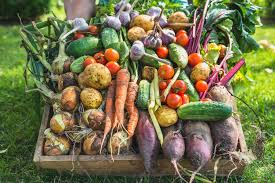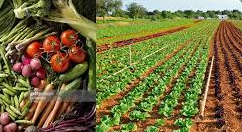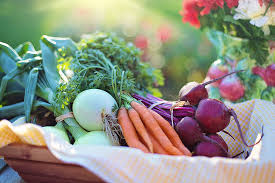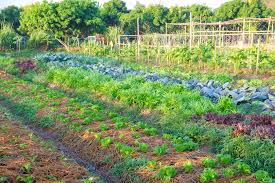Organic vegetable farming is a sustainable and natural approach to growing vegetables without the use of synthetic chemicals, pesticides, or genetically modified organisms (GMOs). This method focuses on building healthy soil, conserving water, and promoting biodiversity to produce nutritious and flavorful vegetables while preserving the environment.
The foundation of organic vegetable farming lies in soil health. Farmers enrich the soil using organic matter like compost, manure, and cover crops. These materials improve soil structure, increase nutrient content, and enhance the soil’s ability to retain moisture. By maintaining healthy soil, organic farmers can grow robust and resilient vegetables. Crop rotation is another crucial practice in organic farming. By planting different types of vegetables in succession, farmers can prevent soil depletion and reduce the risk of pests and diseases. This practice also helps maintain soil fertility and promotes biodiversity on the farm.
Organic pest and disease management relies on natural methods and biological controls. Farmers encourage beneficial insects, such as ladybugs and predatory beetles, that prey on pests. They also use organic sprays made from natural substances like neem oil or garlic to deter harmful insects. Physical barriers like row covers and netting can protect crops from pests as well. Weeds are managed through mechanical means such as hand-weeding, mulching, and using cover crops to suppress their growth. These practices help maintain a healthy and balanced ecosystem on the farm.
Water management is essential in organic vegetable farming. Farmers use efficient irrigation systems, such as drip irrigation, to minimize water wastage and ensure that plants receive adequate moisture. They also practice rainwater harvesting and employ soil moisture conservation techniques like mulching to retain soil moisture and reduce the need for frequent watering. Biodiversity is a cornerstone of organic vegetable farming. By growing a diverse range of vegetables, farmers create a balanced ecosystem that can better withstand environmental stresses. This diversity also attracts beneficial insects and pollinators, which contribute to healthier crops and higher yields.
Organic vegetable farming also emphasizes the use of heirloom and open-pollinated seeds. These seeds are not genetically modified and have been selected over generations for their taste, resilience, and adaptability to local conditions. By using these seeds, organic farmers help preserve genetic diversity and protect traditional varieties from extinction.
The benefits of organic vegetable farming extend to consumers as well. Organic vegetables are free from synthetic pesticides and GMOs, making them a healthier choice. They are often richer in nutrients and have better flavor compared to conventionally grown produce. Additionally, organic farming practices help protect the environment by reducing pollution, conserving water, and promoting soil health.
However, organic vegetable farming does have its challenges. It can be labor-intensive and may require more time and effort compared to conventional farming methods. Organic farmers must also have a deep understanding of soil health, pest management, and crop rotation to succeed. The transition to organic farming can be difficult, and initial yields may be lower as the soil and ecosystem adjust to new practices.
Despite these challenges, the demand for organic vegetables continues to grow. Consumers are becoming more aware of the benefits of organic produce and are willing to support sustainable farming practices. By choosing organic vegetables, consumers can contribute to a healthier environment and support farmers who are committed to sustainable agriculture.
Organic vegetable farming is a holistic and sustainable approach to growing vegetables. By focusing on soil health, biodiversity, and natural pest management, organic farmers can produce nutritious and flavorful vegetables while preserving the environment. The benefits of organic farming extend beyond the farm, offering consumers healthier food choices and contributing to a more sustainable food system.
Principles of Organic Vegetable Farming

1. Soil Health: The foundation of organic farming is healthy soil. Use compost, green manure, and crop rotation to maintain soil fertility and structure.
2. Crop Diversity: Growing a variety of vegetables enhances biodiversity, reduces the risk of pests and diseases, and improves soil health.
3. Natural Pest Control: Employ integrated pest management (IPM) techniques, such as introducing beneficial insects, using natural pesticides, and practicing crop rotation.
4. Water Management: Implement efficient irrigation methods like drip irrigation to conserve water and maintain soil moisture.
5. Organic Seeds: Use organic seeds and planting materials to ensure compliance with organic standards and enhance crop resilience.
Steps to Start an Organic Vegetable Farm
1. Soil Testing: Conduct soil tests to determine pH, nutrient levels, and texture. Amend soil based on test results to optimize fertility.
2. Selecting Vegetables: Choose vegetables suited to your climate, soil, and market demand. Consider a mix of leafy greens, root vegetables, and fruiting plants.
3. Crop Planning: Develop a crop rotation plan to prevent soil depletion, reduce pest and disease pressure, and maintain soil fertility.
4. Composting: Create compost from organic matter like kitchen scraps, yard waste, and manure to enrich soil.
5. Pest Management: Use natural pest control methods such as neem oil, insecticidal soaps, and companion planting to manage pests.
6. Irrigation: Install efficient irrigation systems, such as drip or soaker hoses, to provide consistent moisture while conserving water.
7. Certification: Obtain organic certification by following organic standards, maintaining detailed records, and undergoing regular inspections.
8. Marketing: Develop a marketing strategy to sell your organic vegetables. Consider farmers’ markets, CSA programs, local grocery stores, and online platforms.
Read Also: Boston Terrier: Description, Origin, Health and Complete Care Guide
Soil Health and Organic Practices

1. Building Soil Fertility: Organic farming emphasizes the use of natural methods to improve soil fertility. This includes adding organic matter through compost, manure, and green manures, which enrich the soil with nutrients and enhance its structure.
2. Enhancing Soil Structure: Practices such as reduced tillage, crop rotation, and the use of cover crops contribute to improved soil structure. Healthy soil structure promotes better root growth, water infiltration, and aeration.
3. Promoting Soil Biodiversity: Organic farming encourages the growth of beneficial microorganisms, fungi, and earthworms in the soil. These organisms help decompose organic matter, fix nutrients, and improve soil health.
4. Avoiding Synthetic Inputs: Organic vegetable farming prohibits the use of synthetic fertilizers, pesticides, and herbicides. Instead, it relies on natural alternatives and integrated practices to manage soil health and plant growth.
Selecting Organic Seeds and Varieties
1. Organic Certification: Select seeds that are certified organic, meaning they are grown without synthetic chemicals or GMOs. This ensures the integrity of your organic farming practices.
2. Varietal Adaptation: Choose vegetable varieties that are well-adapted to your local climate and soil conditions. Consider factors such as disease resistance, growth habit, and yield potential.
3. Heirloom and Open-Pollinated Seeds: Opt for heirloom and open-pollinated seeds, which are often more resilient and better suited to organic farming practices. These seeds can be saved and replanted year after year.
4. Disease Resistance: Select varieties with natural resistance to common pests and diseases. This reduces the need for interventions and supports the overall health of your vegetable crops.
Pest and Disease Management
1. Integrated Pest Management (IPM): Use IPM strategies to manage pests. This includes monitoring for pests, using biological controls (such as beneficial insects), and employing physical barriers (like row covers).
2. Disease Prevention: Preventative measures include selecting disease-resistant varieties, practicing crop rotation, and maintaining good garden hygiene. Avoid practices that create conditions conducive to disease outbreaks.
3. Natural Remedies: Utilize organic remedies for pest and disease control. Options include neem oil, insecticidal soap, and homemade sprays made from garlic or hot peppers.
4. Encouraging Beneficial Insects: Attract beneficial insects, such as ladybugs and lacewings, which prey on common pests. Planting flowers and herbs that attract these insects can enhance natural pest control.
Organic Fertilizers and Soil Amendments
1. Composting: Use compost to add essential nutrients and organic matter to the soil. Compost improves soil fertility, structure, and moisture retention.
2. Organic Fertilizers: Apply organic fertilizers such as bone meal, blood meal, and fish emulsion to provide necessary nutrients. These fertilizers release nutrients slowly, supporting long-term plant health.
3. Green Manures and Cover Crops: Grow green manures and cover crops to enrich the soil with nutrients and organic matter. These crops also help prevent erosion and suppress weeds.
4. Soil Testing: Regularly test your soil to determine nutrient levels and pH. Adjust soil amendments based on the results to ensure optimal growing conditions for your vegetables.
Watering Techniques for Organic Vegetables
1. Drip Irrigation: Implement drip irrigation systems to provide consistent and efficient watering. Drip irrigation minimizes water waste and reduces the risk of disease by keeping foliage dry.
2. Mulching: Apply organic mulch, such as straw or leaves, to conserve soil moisture, reduce evaporation, and suppress weeds. Mulch also improves soil fertility as it decomposes.
3. Watering Schedule: Establish a watering schedule based on the needs of your vegetable crops and local climate conditions. Water deeply and infrequently to encourage deep root growth.
4. Monitoring Soil Moisture: Regularly check soil moisture levels using a moisture meter or by feeling the soil. Avoid overwatering, which can lead to root rot and other issues.
Harvesting and Post-Harvest Handling
1. Timely Harvesting: Harvest vegetables at their peak maturity to ensure the best flavor and nutritional value. Each vegetable has an optimal harvest time, which can vary based on the variety and growing conditions.
2. Gentle Handling: Handle vegetables carefully to avoid bruising or damage. Use clean, sharp tools for harvesting and avoid excessive handling.
3. Cleaning and Storage: Clean vegetables thoroughly to remove soil and debris. Store them in a cool, dry place or refrigerate as needed to maintain freshness and extend shelf life.
4. Post-Harvest Processing: If applicable, process vegetables promptly to prevent spoilage. This may include washing, sorting, packaging, and preparing vegetables for market or storage.
Organic vegetable farming relies on principles that enhance soil health, select suitable seeds and varieties, and manage pests and diseases naturally. By utilizing organic fertilizers, effective watering techniques, and proper harvesting and handling practices, farmers can produce high-quality vegetables that are both environmentally sustainable and nutritious. Embracing these practices supports the overall health of the garden ecosystem and contributes to the success of organic farming ventures.
Read Also: Maltipoo: Description, Health and Complete Care Guide
Frequently Asked Questions (FAQs) About Organic Vegetable Farming

1. What is organic vegetable farming?
Organic vegetable farming involves growing vegetables without synthetic chemicals, using natural methods to enhance soil health, pest control, and sustainability.
2. How does organic vegetable farming differ from conventional farming?
Organic farming excludes synthetic pesticides and fertilizers, promotes crop diversity, and emphasizes ecological balance, while conventional farming often relies on chemical inputs and monocultures.
3. What are the main benefits of organic vegetable farming?
The main benefits include improved soil health, increased biodiversity, reduced chemical exposure, higher nutrient content in produce, and economic advantages like premium prices and market demand.
4. Is organic vegetable farming more labor-intensive?
Yes, organic vegetable farming can be more labor-intensive due to practices like manual weeding and detailed management of soil health and pest control.
5. Can organic vegetable farming be profitable?
Yes, organic vegetable farming can be profitable due to premium prices for organic produce, growing consumer demand, and reduced costs associated with synthetic inputs.
6. How does organic vegetable farming impact the environment?
Organic farming positively impacts the environment by reducing pollution, conserving water, enhancing soil health, and supporting biodiversity.
7. Are organic vegetables healthier than conventionally grown ones?
Organic vegetables are often healthier as they contain fewer pesticide residues and can have higher levels of certain nutrients, though overall health benefits can vary.
8. What is the cost of converting to organic vegetable farming?
Converting to organic farming can involve costs related to certification, changes in farming practices, and potential initial yield reductions, but long-term benefits often outweigh these costs.
9. How do I get certified as an organic vegetable farmer?
To get certified, follow organic standards set by a certification body, maintain detailed records, and undergo regular inspections to ensure compliance.
10. What are the challenges of organic vegetable farming?
Challenges include managing pests and diseases without synthetic chemicals, maintaining soil fertility, achieving consistent yields, and navigating certification processes.
Read Also: 9 Impressive Health Benefits of Onions

